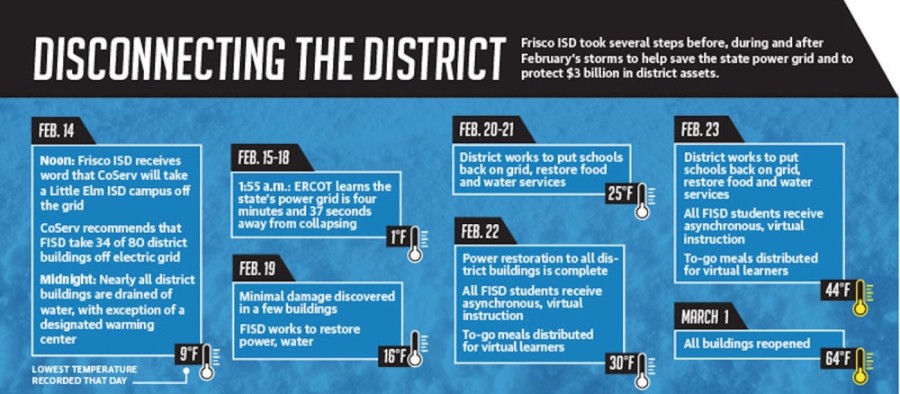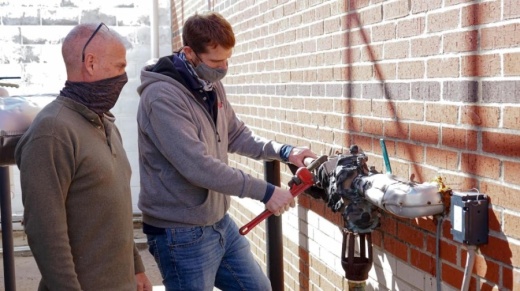District staff disconnected 34 buildings from the power grid and completely drained most buildings of all water.
This move, which staffers said was “unprecedented” for FISD, came at the request of CoServ, one of the district’s utility providers, Director of Emergency Management Jon Bodie said.
Swift action in the early hours of the storm likely prevented “tens of millions of dollars of cleanup,” Deputy Superintendent for Business and Operations Todd Fouche said.
All district students shifted to asynchronous learning while crews inspected 80 buildings, restored electric and water service, and replenished food supplies.
The district is still working on assessing cost estimates for minor damages. At a March 1 school board meeting, Superintendent Mike Waldrip said FISD did not sustain serious damages.
“There are school districts all around us that have buildings that are still out of commission and will be until after spring break—and some until the end of the year. And that is not FISD,” Waldrip said.
Unplugging Frisco
Fouche said FISD resisted acting on CoServ’s request until staffers learned that getting off the grid might help the entire state.

This concern turned out to be legitimate: Electric Reliability Council of Texas CEO Bill Magness said that at 1:55 a.m. on Feb. 15, the grid was about 4 minutes and 37 seconds away from a statewide blackout. FISD agreed to take 34 campuses completely off the grid at CoServ’s urging.
Administrators also decided to drain all water from district buildings to prevent pipes from freezing and rupturing, as there would be no power to provide heat, Waldrip wrote in a letter.
Although the district does not know precisely how many gallons of water were drained in this process, Fouche said it numbered in the thousands.
Crews disconnected and drained three water systems: the domestic water system, which is for water fountains and sinks; the heating, ventilation and air conditioning system; and the fire-suppression system.
“We’ve never done anything like this before,” Fouche said.
After two days of working in freezing temperatures, Fouche said, the crews were finished. Bodie said communication during the chaos of the freeze was a pain point due to a lack of reliable internet and phone connection.
“Voice calls sometimes got dropped. Data availability was sometimes in and out,” Bodie said.
Protecting $3 billion in assets
Ultimately, minor damage occurred at just a few schools, Bodie said. Issues included minor flooding and broken pipes—but nothing like the extensive flooding some other Texas school districts are facing, staff said.

“Because the water was shut off, the flood was fairly minimal. ... If the water wouldn’t have been turned off, it would have been thousands of gallons of water coming out, like some of our neighboring districts,” Fouche said.
While these proactive measures protected FISD’s $3 billion in assets, they also resulted in a delayed return to in-person classes. Elementary students returned to campus Feb. 24, and many middle school students followed shortly after; however, some high school students did not resume in-person learning until March 1.
FISD will not make up school days missed due to the storm.
District staff said the expedited return to campus for elementary students was a strategic move to help parents of younger students.
“It’s not a coincidence that our elementary [schools] came up first,” Fouche said.
“It’s obviously a lot harder for parents with little ones if they need to get back to work. It’s harder to teach and learn if you’re a kindergartener online versus a senior.”
To make it possible for all in-person learners to return to school, district maintenance employees spent 11 days, including weekends, pulling 12- to 14-hour shifts to get all 79 affected district buildings back online.
By the end of February, when all buildings were fully functional again, maintenance staff had worked between 5,000 and 7,500 hours, staff said.
Fouche said the most challenging obstacle to reopening buildings was restoring fire-suppression systems.
“[Anybody] can go and take the plugs out and drain them. But you have to have a certified person there to recharge, or refill, the fire-suppression systems,” Fouche said.
However, these certified individuals were in high demand after the storm. While students were at home, FISD board trustee René Archambault said, teachers and district staff were still actively serving students.
“Many of them were just pulling incredible hours working around the clock to make sure that lesson plans were ready,” Archambault said.
Even though unplugging FISD was a taxing endeavor for the district, staffers said they feel it was the right decision.
“We’ve had positive responses from community members, [saying], ‘Thank you for what you’re doing. Thank you for helping the grid,’” Fouche said.
During the March 1 board meeting, Fouche called out dozens of maintenance workers by name, saying the district was “really, really indebted” to those employees, some of whom worked three weeks straight without any days off.





